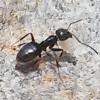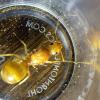- Formiculture.com
- Forums
- Gallery
- Members
- Member Map
- Chat

Capturing wild colonies
Started By
noobkeeper
, Feb 26 2017 1:52 PM
29 replies to this topic
#21
 Offline
Guest_SolenopsisKeeper_*
-
Posted February 27 2022 - 6:22 AM
Offline
Guest_SolenopsisKeeper_*
-
Posted February 27 2022 - 6:22 AM
Well, I think if someone is spraying a lot with pesticides, and they don’t care if you relocate, it is probably okay to dig it up.
#22
 Offline
-
Posted February 27 2022 - 11:48 PM
Offline
-
Posted February 27 2022 - 11:48 PM
Has anyone tried catching a foundling colony/wandering queen through baiting?
I am new to ants and maybe don't fully understand their behavior, but I thought that with the idea that some ants may bring the brood closer to the food rather than the food to the brood/queen. Could you potentially make a container of substrate more desirable than the surrounding area (i.e. with honey) would they potentially move brood and a young queen into the container? I'm assumming this could only work with multi queen wild colonies or ones with young queens about to leave anyways?
Purely just the random wild thoughts of an amateur. Food for thought?
I am new to ants and maybe don't fully understand their behavior, but I thought that with the idea that some ants may bring the brood closer to the food rather than the food to the brood/queen. Could you potentially make a container of substrate more desirable than the surrounding area (i.e. with honey) would they potentially move brood and a young queen into the container? I'm assumming this could only work with multi queen wild colonies or ones with young queens about to leave anyways?
Purely just the random wild thoughts of an amateur. Food for thought?
#23
 Online
-
Posted February 28 2022 - 9:33 AM
Online
-
Posted February 28 2022 - 9:33 AM
Baiting will not work.
- Manitobant, OiledOlives and DRpepper like this
"The ants are a people not strong, yet they prepare their meat in the summer." Prov. 30:25
Keep ordinary ants in extraordinary ways.
Keep ordinary ants in extraordinary ways.
#24
 Offline
Guest_SolenopsisKeeper_*
-
Posted February 28 2022 - 5:08 PM
Offline
Guest_SolenopsisKeeper_*
-
Posted February 28 2022 - 5:08 PM
Have never tried… might work, and if it did you would have to continuously feed the ants in that spot, and eventually they might move there. Would have to ask an expert. I have had black crazy ants make a satellite nest next to some nectar I left outside.Has anyone tried catching a foundling colony/wandering queen through baiting?
I am new to ants and maybe don't fully understand their behavior, but I thought that with the idea that some ants may bring the brood closer to the food rather than the food to the brood/queen. Could you potentially make a container of substrate more desirable than the surrounding area (i.e. with honey) would they potentially move brood and a young queen into the container? I'm assumming this could only work with multi queen wild colonies or ones with young queens about to leave anyways?
Purely just the random wild thoughts of an amateur. Food for thought?
#25
 Online
-
Posted February 28 2022 - 5:25 PM
Online
-
Posted February 28 2022 - 5:25 PM
The whole point if eusociality is to ensure queens don’t have to risk death foraging for food. Baiting will not get you a queen.
"The ants are a people not strong, yet they prepare their meat in the summer." Prov. 30:25
Keep ordinary ants in extraordinary ways.
Keep ordinary ants in extraordinary ways.
#26
 Offline
-
Posted February 28 2022 - 5:26 PM
Offline
-
Posted February 28 2022 - 5:26 PM
The only time I can think of where baiting might work is with highly polygynous and nomadic species.
Edited by OiledOlives, February 28 2022 - 5:27 PM.
#27
 Offline
-
Posted February 28 2022 - 6:41 PM
Offline
-
Posted February 28 2022 - 6:41 PM
So I did it anyways. . .
And caught another T. sessile Queen and a few workers just the day after I put it out!
I took a Tupperware container with the vent style lid and opened it. I put dirt substrate and a small jar of honey water as I hear that was the best bait for the garbage ants. I used a stick to connect the lid of the Tupperware with an existing trail/line of ants.
That trap was only out overnight and it already seemed to work? Maybe later in the season I'll try this method with maybe less easy to lure ants?
And caught another T. sessile Queen and a few workers just the day after I put it out!
I took a Tupperware container with the vent style lid and opened it. I put dirt substrate and a small jar of honey water as I hear that was the best bait for the garbage ants. I used a stick to connect the lid of the Tupperware with an existing trail/line of ants.
That trap was only out overnight and it already seemed to work? Maybe later in the season I'll try this method with maybe less easy to lure ants?
Edited by Malachite, February 28 2022 - 6:45 PM.
#28
 Offline
Guest_SolenopsisKeeper_*
-
Posted February 28 2022 - 8:26 PM
Offline
Guest_SolenopsisKeeper_*
-
Posted February 28 2022 - 8:26 PM
Well this doesn’t mean you have a fertile queen, as in some species there will be (I forget scientific term for it) queens that act as workers and do not lay eggs.
I don’t know if this happens in that particular species, but here is an article for something similar in Acromyrmex
Link:
https://phys.org/new...ants-roles.html
.
But this could very much be a queen,fertile and laying eggs.(Note: Even if eggs do appear, she still may not be laying them as workers can lay eggs without the pheromone of a mated queen(Becomes males(Wait until you get workers before making plans)))
To prove this I quote antwiki
“ Life History Traits
Queen number: secondarily polygynous (7 queens present, 2 physogastric, others show worker-like behaviours)
Queen type: winged or dealate
Male type: winged
Worker caste: present
Mean colony size: 200”-Odontomachus Clarus page.
Also question, if the Clarus queens were worker like, couldn’t one catch one of these, and it turn up with males? I have a colony that I brood boosting after the queen got larvae, and now cocoons are very different in sizes so…males, nanitic workers?
I don’t know if this happens in that particular species, but here is an article for something similar in Acromyrmex
Link:
https://phys.org/new...ants-roles.html
.
But this could very much be a queen,fertile and laying eggs.(Note: Even if eggs do appear, she still may not be laying them as workers can lay eggs without the pheromone of a mated queen(Becomes males(Wait until you get workers before making plans)))
To prove this I quote antwiki
“ Life History Traits
Queen number: secondarily polygynous (7 queens present, 2 physogastric, others show worker-like behaviours)
Queen type: winged or dealate
Male type: winged
Worker caste: present
Mean colony size: 200”-Odontomachus Clarus page.
Also question, if the Clarus queens were worker like, couldn’t one catch one of these, and it turn up with males? I have a colony that I brood boosting after the queen got larvae, and now cocoons are very different in sizes so…males, nanitic workers?
#29
 Offline
-
Posted February 28 2022 - 10:40 PM
Offline
-
Posted February 28 2022 - 10:40 PM
This “worker-esk queen behavior is only typically in semi-claustral ants such as previously stated Acromyrmex and is a rare occurrence and does not happen with T. sessile and as for the O. clarus, these are also semi-claustral and forage along with workers in extremely young founding stages. Someone PLEASE correct me if I’m wrong.Well this doesn’t mean you have a fertile queen, as in some species there will be (I forget scientific term for it) queens that act as workers and do not lay eggs.
I don’t know if this happens in that particular species, but here is an article for something similar in Acromyrmex
Link:
https://phys.org/new...ants-roles.html
.
But this could very much be a queen,fertile and laying eggs.(Note: Even if eggs do appear, she still may not be laying them as workers can lay eggs without the pheromone of a mated queen(Becomes males(Wait until you get workers before making plans)))
To prove this I quote antwiki
“ Life History Traits
Queen number: secondarily polygynous (7 queens present, 2 physogastric, others show worker-like behaviours)
Queen type: winged or dealate
Male type: winged
Worker caste: present
Mean colony size: 200”-Odontomachus Clarus page.
Also question, if the Clarus queens were worker like, couldn’t one catch one of these, and it turn up with males? I have a colony that I brood boosting after the queen got larvae, and now cocoons are very different in sizes so…males, nanitic workers?
Currently: Considering moving to Australia
Reason: Myrmecia
Reason: Myrmecia
#30
 Offline
-
Posted March 1 2022 - 5:20 AM
Offline
-
Posted March 1 2022 - 5:20 AM
"Worker queens", as they are commonly referred to in the hobby, are pretty common in some genera, such as Aphaenogaster. I have never heard of it happening in T. sessile, however, and the queen that Malachite collected is probably mated. I would recommend finding the nest and collecting as many workers and queens as possible so you can have an actually interesting colony as a single Tapinoma queen will get boring very fast.
- ZTYguy likes this
1 user(s) are reading this topic
0 members, 1 guests, 0 anonymous users


















